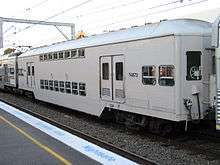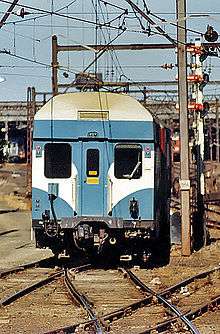Sydney Trains S set
| S Sets | |
|---|---|
|
S set at Erskineville in December 2013 | |
|
Goninan trailer car vestibule with stairs leading to upper & lower decks after refurbishment | |
| In service | 1972–present |
| Manufacturer |
Comeng A Goninan & Co |
| Built at |
Granville Broadmeadow |
| Constructed | 1972–80 |
| Entered service | 1972 |
| Refurbishment | 1990s |
| Number built | 509 cars |
| Number in service | 192 cars |
| Formation | 4 car sets |
| Fleet numbers | C3805-C3986, C3741-C3765, C3001-C3080, D4011-D4095, T4101-T4170, T4921-T4987 |
| Capacity |
112 seated (Comeng power cars) 113 seated (Goninan power cars) 130 seated (trailer cars, both types) |
| Operator(s) | Sydney Trains |
| Depot(s) | Flemington |
| Line(s) served |
T7 Olympic Park T2 Airport, Inner West & South Line |
| Specifications | |
| Car length |
Comeng: 20.22 m (66 ft 4 in) Goninan: 20.22 m (66 ft 4 in) |
| Width |
Comeng: 3.08 m (10 ft 1 in) Goninan: 3.04 m (10 ft 0 in) |
| Height |
Comeng: 4.38 m (14 ft 4 in) Goninan: 4.37 m (14 ft 4 in) |
| Maximum speed | 115 km/h (71 mph) |
| Weight |
Comeng: 47 tonnes (46 long tons; 52 short tons) Goninan: 45 tonnes (44 long tons; 50 short tons) |
| Traction system |
4 × Mitsubishi 150 kW (200 hp) |
| Track gauge | 1,435 mm (4 ft 8 1⁄2 in) |
The S sets are a class of electric multiple unit operated by Sydney Trains in New South Wales, Australia. The carriages are of stainless steel, double deck construction and are not air conditioned. The class is currently the oldest in the Sydney Trains fleet, and is the only train in the entire fleet that is not air-conditioned.
Delivery
Two manufacturers built 509 carriages, based on a largely common design:
- 359 carriages were built by Comeng between 1972 & 1980.[1] They are externally distinguished by the peaked front of driving cars.
- Power cars: C3805-C3986 and C3741-C3765
- Trailer cars: T4921-T4987
- Driving trailer cars: D4011-D4095
- 150 carriages built by A Goninan & Co between 1978 & 1980.[2] They are externally distinguished by the flat front of driving cars and lower windows on the upper deck.
- Power cars: C3001-C3080
- Trailer cars: T4101-T4170
History

.jpg)

Following the successful trial of four double deck power cars built by Tulloch in 1968, 53 Series 1 power cars were ordered from Comeng and delivered in 1972–73.[3] They were paired with 1965–67 Tulloch built trailer carriages that had previously operated in company with single deck power cars. The first 39 were painted tuscan to match the trailer cars while the last 14 were painted in the newly introduced Public Transport Commission blue and white livery.
From 1976 the blue and white livery was replaced by an Indian red livery. In 1979, painted Series 1 cars began to have their paint removed to match the Series 2 cars. Only seven were completed, and it wasn't until August 1988 that the program recommenced with the last carriage treated in 1990.[4][5]
Subsequent orders saw another 154 power cars, 67 trailer cars and 85 driving trailer cars built by Comeng. These were all built to the Series 2 design with Budd type polished inserts on the carriage sides, flat rather than tapered number 2 ends, throw-over rather than sliding reversible seats, upgraded interior lights and a natural stainless steel finish.[3]
A further order saw 80 power cars and 70 trailer cars constructed by A Goninan & Co in 1978–80. These cars differed in having a squarer type of fluting and flat fronts on the power cars.
All were formed into either four car S sets or two car T sets. In practice there were only a few diagrams requiring two carriage sets resulting in most T sets being used to form six and eight car sets. By the early 1980s some permanent six car sets had been formed and targeted as R sets. In December 1983 there were 60 T sets, 12 months later this was down to 19.[6][7]
In April 1982, ten driving trailers were introduced on local services between Scarborough and Port Kembla. These two car PK sets ran until the line was electrified in December 1985.[8] They were hauled by 48 class diesels but because of incompatibility between the electrical systems, the automatic doors were disconnected.
From June 1984, 4 three car sets of Goninan stock operated suburban services from Newcastle to Fassifern and Morisset as NC sets.[9] This stock was allocated to Mortdale and periodically rotated. In August 1989, this was reduced to two sets.[10] In September 1989, the remaining NC sets were replaced by two carriage L sets from Hornsby.[11] These were replaced in January 1992.[12]
In May 1987, the ten newest driving trailers based as Hornsby were renumbered D4001-D4010 and the remainder began to have their control equipment removed and revert to ordinary trailers.[13] To allow the Tangaras to be targeted as T sets, the remaining two car sets became L sets in April 1988.[14][15] When refurbished in the 1990s the crew compartments were removed.[16]
To operate services on the newly electrified Riverstone to Richmond line from August 1991, all 10 driving trailers and a number of Series 1 power cars were fitted with headlights.[17]
From October 1996, two car L sets replaced U sets on suburban services between Thirroul, Port Kembla and Kiama.[18] These were later extended to three cars before being replaced by Tangaras in October 2011.
During the 1990s, all carriages were refurbished as part of the CityDecker program. This saw the interiors refurbished with white walls and ceilings, grey floors and blue seats. Power cars received a destination indicator and had yellow applied to the lower half of their fronts. Sliding Beclawat windows were replaced with hopper windows and doors painted yellow.
Replacement
After nearly 40 years of service, the Tulloch trailers were deemed life expired and the last withdrawn in March 2004. This resulted in a disproportionate number of power cars. To address the balance 23 Comeng power cars were converted into trailers. Most of the conversions were Series 1 cars, however a few conversions involved Series 2 cars. This involved the removal of the yellow painted front (on some cars), pantograph and opening up of the driving compartment for passengers.
Some cars had their external lights removed and plated over, and their cabs removed, other retained these fittings. All retained their motors and compressors for ballast purposes. The destination indicator was also retained as it would cost too much to have them removed, they were painted over instead. These cars are easy to recognise as they have an open space where the pantograph once was.
All remaining 498 carriages were to be replaced by A sets from 2012, with the last scheduled for replacement in 2015.[19] In March 2013, it was revealed a limited number of S sets would need to be retained after the full introduction of the A sets, as the option to build further A sets had lapsed, meaning no trains had been ordered for the South West Rail Link.[20] The last Series 1 powercar was withdrawn in January 2014. The final A set was delivered in June 2014.[21]
In May 2014, the State Government announced its intention to purchase 520 new carriages for the NSW TrainLink intercity network, with deliveries to commence in 2019. These new trains will release at least some H sets from intercity services, allowing them to be transferred to Sydney Trains to replace the remaining S sets.[22]
Today
During their history, S sets operated on all Sydney lines. The last R sets were disbanded in August 2012, with all carriages formed into four car S sets. The last sets were transferred from Mortdale to Flemington in March 2013 bringing an end to their operation on Eastern Suburbs & Illawarra services. However one set remained operational through parts of March and April on the line. In May 2014, all Hornsby sets were transferred to Flemington for operation on sector 2.
Following the delivery of the final A sets, Sydney Trains retained 48 four car sets. In June 2014, the government announced that all timetabled services except those on the T7 Olympic Park shuttle, would be operated by air-conditioned trains.[21]
References
- ↑ L, R and S Set (Comeng type) control motor - CityRail (Internet Archive)
- ↑ R and S Set (Goninan type) control motor - CityRail (Internet Archive)
- 1 2 Dunn, John (2010). Comeng A History of Commonwealth Engineering Volume 3 1966-1977. Rosenberg Publishing. pp. 151–173. ISBN 9781877058905.
- ↑ "EMU Review" Railway Digest March 1989 page 86
- ↑ "Rolling Stock - The EMU Review" Railway Digest March 1991 page 96
- ↑ "Deployment of the Electric Train Fleet as at 31/12/83" Railway Digest March 1984 page 88
- ↑ "EMU Review" Railway Digest March 1985 page 61
- ↑ "1982/83 SRA Annual Report" Railway Digest June 1984 page 212
- ↑ "Rostering Electrics to Newcastle" Railway Digest August 1984 page 250
- ↑ "Electric Cars" Railway Digest August 1989 page 281
- ↑ "Electric Cars" Railway Digest December 1989 page 414
- ↑ "The New Timetable" Railway Digest December 1991 page 454
- ↑ "The Thirty-First of May" Railway Digest July 1987 page 210
- ↑ "EMU Review" Railway Digest March 1988 page 77
- ↑ "L Sets" Railway Digest June 1988 page 219
- ↑ "A Review of Electric Multiple Unit rolling stock" Railway Digest September 1996 page 31
- ↑ "Rolling Stock - The EMU Review" Railway Digest March 1992 page 113
- ↑ "EMU Review" Railway Digest March 1997 page 38
- ↑ Railcorp selling off train carriages - perfect for the person who has everything Daily Telegraph 29 December 2011
- ↑ Commuters stuck with old trains on new rail link Sydney Morning Herald 15 March 2013
- 1 2 "NSW Government delivers final Waratah train: all Sydney services air-conditioned". Transport for NSW. 2 June 2014. Retrieved 3 June 2014.
- ↑ "NSW Government to invest $2.8 billion in new intercity trains, making all trains air-conditioned". Transport for NSW. 8 May 2014.
Beckhaus, John; Halgren, Stephen (2007), Sydney's Electric Trains, Australian Railway Historical Society NSW Division, ISBN 978-0-9757870-8-3
External links
 Media related to S sets at Wikimedia Commons
Media related to S sets at Wikimedia Commons- Technical drawings and specifications

